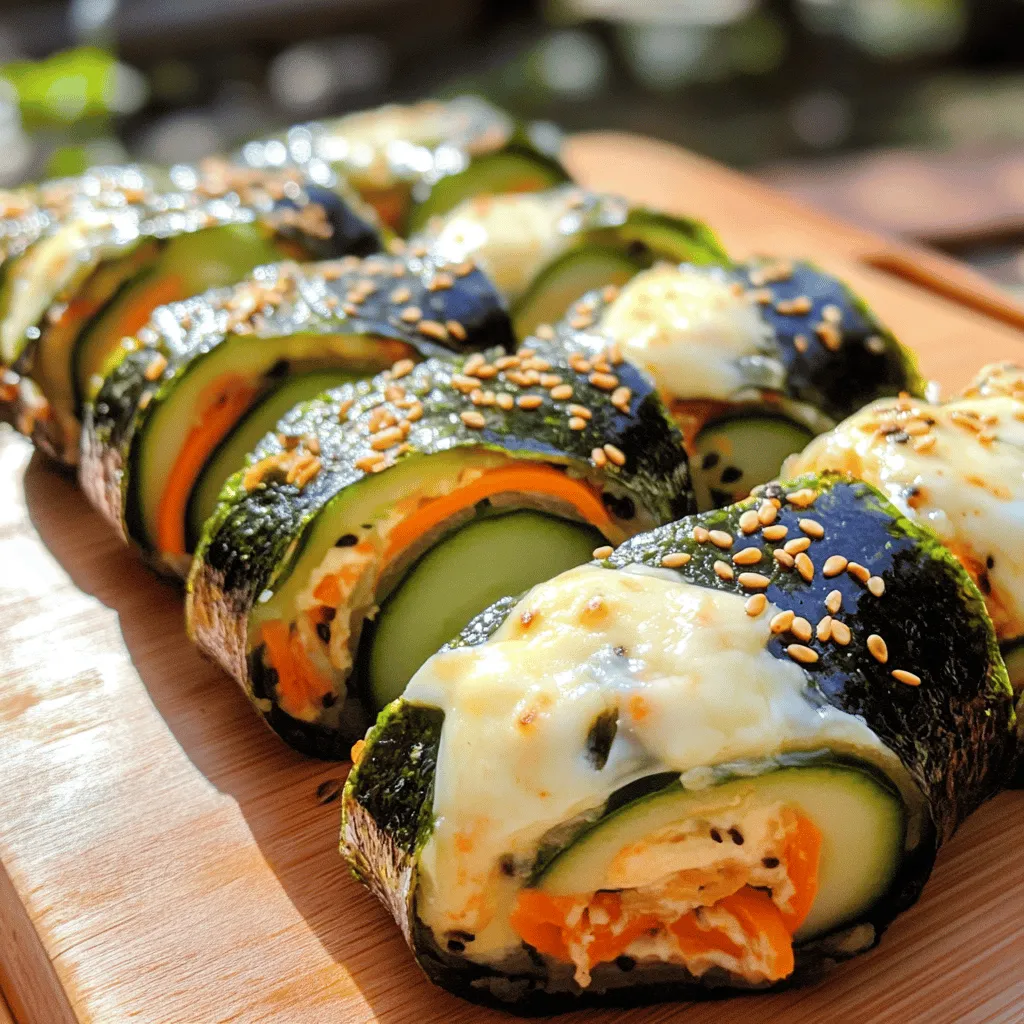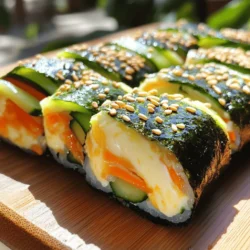Looking to spice up your meal routine? Korean Cheese Kimchi Kimbap is a simple and tasty dish you can’t miss. Packed with bold flavors and creamy cheese, this dish is fun to make and even better to eat. Whether you’re a seasoned chef or a kitchen newbie, I’ll guide you through each step. Let’s dive in and get ready to roll your own delicious kimbap!
Ingredients
List of essential ingredients for Korean Cheese Kimchi Kimbap
To make Korean Cheese Kimchi Kimbap, you need these key ingredients:
- 2 cups cooked short-grain rice
- 2 tablespoons rice vinegar
- 1 teaspoon sugar
- 1 teaspoon salt
- 1 cup kimchi, drained and chopped
- 1 cup mozzarella cheese, shredded
- 1 medium cucumber, julienned
- 1 medium carrot, julienned
- 4 sheets of roasted seaweed (nori)
- Sesame oil, for brushing
- Toasted sesame seeds, for garnish
These ingredients create a burst of flavors in each bite. The rice pairs well with the tangy kimchi and melty cheese.
Optional ingredients for customization
You can change the recipe to suit your taste. Here are some ideas:
- Avocado slices for creaminess
- Cooked egg strips for protein
- Spinach or lettuce for extra crunch
- Different types of kimchi for varied spice levels
Feel free to mix and match these options. This flexibility makes the dish more fun.
Tips for selecting quality ingredients
Choosing great ingredients is key to tasty kimbap. Here’s how to do it:
- Rice: Use short-grain rice. It sticks together and holds the filling well.
- Kimchi: Go for fresh, crunchy kimchi. The flavor should be tangy but not too strong.
- Cheese: Choose high-quality mozzarella. Freshly shredded cheese melts better.
- Vegetables: Pick firm cucumbers and bright carrots. They add color and crunch.
- Nori: Look for dark, shiny sheets. They should feel crisp and not stale.
By picking quality ingredients, you enhance the overall taste and presentation. This helps you create a dish that’s both beautiful and delicious.
Step-by-Step Instructions
Overview of preparation method
Making Korean Cheese Kimchi Kimbap is easy. First, you prepare the rice. Then, you assemble the filling. Finally, you roll it all up. Each step is fun and simple.
Detailed instructions for assembling kimbap
1. In a medium bowl, mix two cups of cooked short-grain rice with two tablespoons of rice vinegar, one teaspoon of sugar, and one teaspoon of salt. Stir until the rice is seasoned well.
2. Grab a bamboo sushi mat and place it on a clean surface. Lay a sheet of roasted seaweed (nori) on top, shiny side down.
3. Wet your hands to prevent sticking. Spread a thin layer of the seasoned rice over the nori. Leave about one inch of space at the top.
4. In the center, add a line of chopped kimchi. Next, sprinkle a cup of shredded mozzarella cheese. Then, add a julienned cucumber and a julienned carrot.
5. Lift the edge of the mat closest to you. Begin rolling the kimbap tightly away from you. Press gently to keep the filling inside. Roll until you reach the edge of the nori.
6. To seal the kimbap, brush a little sesame oil on the exposed edge of the nori. Press it down to close.
7. Use a sharp knife to cut the rolled kimbap into bite-sized pieces. Wipe the knife with a damp cloth after each cut.
8. Place the kimbap on a platter and sprinkle with toasted sesame seeds before serving.
Tips for perfecting the rolling technique
Rolling kimbap takes practice. Here are some tips to help you:
- Keep the filling in the center. This helps with even rolling.
- Use gentle pressure while rolling. This keeps the kimbap tight but not too squished.
- Make sure to seal the edge well. This keeps everything inside during slicing.
- Practice with less filling if you’re new. It makes rolling easier.
Follow these steps, and you will create a delicious and beautiful Korean Cheese Kimchi Kimbap.
Tips & Tricks
Common mistakes to avoid while making kimbap
When making kimbap, a few mistakes can spoil your fun. First, don’t overfill your kimbap. Too much filling makes it hard to roll. Keep it simple and balanced. Second, make sure your rice is not too wet. Wet rice can make kimbap soggy. Aim for sticky yet dry rice. Lastly, avoid cutting with a dull knife. A sharp knife helps you make clean slices.
How to achieve the best flavor and texture
To get the best flavor, use good-quality kimchi. The right kimchi adds depth and spice. Also, don’t skip the mozzarella cheese. It melts well and adds creaminess. For texture, julienne your cucumber and carrot thinly. This gives a nice crunch. Lastly, brush the nori with sesame oil. This adds a toasted flavor and helps to seal the roll.
Suggested tools and equipment for easy preparation
Having the right tools makes cooking easier. Use a bamboo sushi mat for rolling; it keeps your kimbap tight. A sharp knife is key for slicing; it helps with clean edges. Also, keep a bowl of water nearby. Wet hands prevent the rice from sticking. Finally, use a medium bowl for mixing rice and seasonings. It keeps everything organized and neat.

Variations
Different types of kimchi to use
You can try many kimchi types for your kimbap. Each type adds a unique taste. Napa cabbage kimchi is the classic choice. It brings a crunchy texture and tangy flavor. You might also enjoy radish kimchi, which is crisp and mildly spicy. For a bold kick, try spicy green onion kimchi. It will give your kimbap an exciting twist.
Cheese alternatives for flavor pairing
While mozzarella cheese is great, you can switch it up. Creamy cheddar adds a sharp taste. Pepper jack cheese brings a spicy zing. If you love blue cheese, it can give a strong flavor. For a vegan option, try cashew cheese. It melts well and keeps the dish rich and creamy.
Seasonal ingredient swaps for a fresh twist
Using seasonal ingredients can brighten up your kimbap. In spring, add fresh herbs like mint or basil. They bring a burst of color and flavor. Summer is perfect for ripe avocados or sweet bell peppers. In fall, roasted sweet potatoes can add warmth. Winter is great for adding pickled vegetables. They give a nice tang and crunch to your kimbap.
Storage Info
How to store leftover kimbap
To keep your leftover kimbap fresh, wrap it tightly in plastic wrap. This method locks in moisture and keeps it from drying out. You can also place it in an airtight container. Make sure to store it in the fridge. This way, it can last for a few days.
Best methods for reheating kimbap
When reheating kimbap, use a microwave for a quick option. Place the kimbap on a microwave-safe plate and cover it with a damp paper towel. Heat it in short bursts of 15 seconds. This keeps the rice soft. You can also use a skillet. Heat it over low heat for a few minutes. This method helps maintain the crispiness of the seaweed.
Shelf life and freshness tips
Kimbap stays fresh for about 2 to 3 days in the fridge. After that, it might lose its taste and texture. To check for freshness, look for any off smells or changes in texture. If it feels dry or hard, it’s time to toss it. Enjoy it quickly for the best flavor!
FAQs
What is the difference between kimbap and sushi?
Kimbap and sushi look alike, but they have key differences. Kimbap uses sesame oil, while sushi uses rice vinegar. Kimbap has cooked or pickled fillings, like kimchi and cheese. Sushi often includes raw fish. Kimbap rolls are also usually thicker and have a more diverse mix of flavors. Each bite is a burst of taste, making kimbap a fun meal.
Can I make kimbap ahead of time?
Yes, you can make kimbap ahead of time. It tastes great even after a few hours. Wrap each roll tightly in plastic wrap. This keeps it fresh. Store it in the fridge until you are ready to eat. If you plan to eat it later, hold off on adding sesame seeds until serving time.
Is there a vegetarian version of Korean Cheese Kimchi Kimbap?
Absolutely! To make a vegetarian version, use vegan cheese or skip the cheese altogether. You can add more veggies, like bell peppers or spinach. You can also use a milder kimchi that fits your taste. This makes the dish light and fresh without losing flavor.It’s simple and fun to make!
Korean Cheese Kimchi Kimbap is a fun dish to make at home. We explored key ingredients, steps for rolling, and tips for great flavor. I shared variations, storage tips, and answered common questions.
You can easily customize the kimbap with fresh ingredients. Enjoying this dish is rewarding and tasty. Try it for your next meal, and impress your family or friends. Making kimbap allows you to be creative and have fun in the kitchen. Dive in and enjoy the process!


